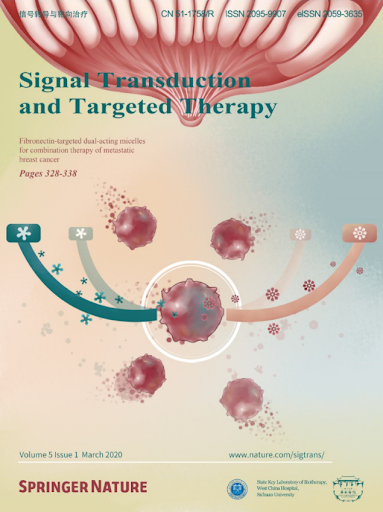The molecular mechanism and therapeutic landscape of copper and cuproptosis in cancer.
IF 40.8
1区 医学
Q1 BIOCHEMISTRY & MOLECULAR BIOLOGY
引用次数: 0
Abstract
Copper, an essential micronutrient, plays significant roles in numerous biological functions. Recent studies have identified imbalances in copper homeostasis across various cancers, along with the emergence of cuproptosis, a novel copper-dependent form of cell death that is crucial for tumor suppression and therapeutic resistance. As a result, manipulating copper levels has garnered increasing interest as an innovative approach to cancer therapy. In this review, we first delineate copper homeostasis at both cellular and systemic levels, clarifying copper's protumorigenic and antitumorigenic functions in cancer. We then outline the key milestones and molecular mechanisms of cuproptosis, including both mitochondria-dependent and independent pathways. Next, we explore the roles of cuproptosis in cancer biology, as well as the interactions mediated by cuproptosis between cancer cells and the immune system. We also summarize emerging therapeutic opportunities targeting copper and discuss the clinical associations of cuproptosis-related genes. Finally, we examine potential biomarkers for cuproptosis and put forward the existing challenges and future prospects for leveraging cuproptosis in cancer therapy. Overall, this review enhances our understanding of the molecular mechanisms and therapeutic landscape of copper and cuproptosis in cancer, highlighting the potential of copper- or cuproptosis-based therapies for cancer treatment.铜在癌症中的分子机制和治疗前景。
铜是人体必需的微量元素,在许多生物功能中起着重要作用。最近的研究已经确定了各种癌症中铜稳态的不平衡,以及铜增生的出现,铜增生是一种新的依赖铜的细胞死亡形式,对肿瘤抑制和治疗抵抗至关重要。因此,作为一种创新的癌症治疗方法,操纵铜水平已经引起了越来越多的兴趣。在这篇综述中,我们首先描述了铜在细胞和系统水平上的稳态,阐明了铜在癌症中的致原性和抗肿瘤功能。然后,我们概述了铜体发育的关键里程碑和分子机制,包括线粒体依赖和独立途径。接下来,我们将探讨铜移在癌症生物学中的作用,以及由铜移介导的癌细胞与免疫系统之间的相互作用。我们还总结了针对铜的新兴治疗机会,并讨论了铜中毒相关基因的临床关联。最后,我们研究了铜突起的潜在生物标志物,并提出了利用铜突起在癌症治疗中的现有挑战和未来前景。总的来说,这篇综述提高了我们对铜和铜沉淀在癌症中的分子机制和治疗前景的理解,强调了铜或铜沉淀为基础的癌症治疗方法的潜力。
本文章由计算机程序翻译,如有差异,请以英文原文为准。
求助全文
约1分钟内获得全文
求助全文
来源期刊

Signal Transduction and Targeted Therapy
Biochemistry, Genetics and Molecular Biology-Genetics
CiteScore
44.50
自引率
1.50%
发文量
384
审稿时长
5 weeks
期刊介绍:
Signal Transduction and Targeted Therapy is an open access journal that focuses on timely publication of cutting-edge discoveries and advancements in basic science and clinical research related to signal transduction and targeted therapy.
Scope: The journal covers research on major human diseases, including, but not limited to:
Cancer,Cardiovascular diseases,Autoimmune diseases,Nervous system diseases.
 求助内容:
求助内容: 应助结果提醒方式:
应助结果提醒方式:


